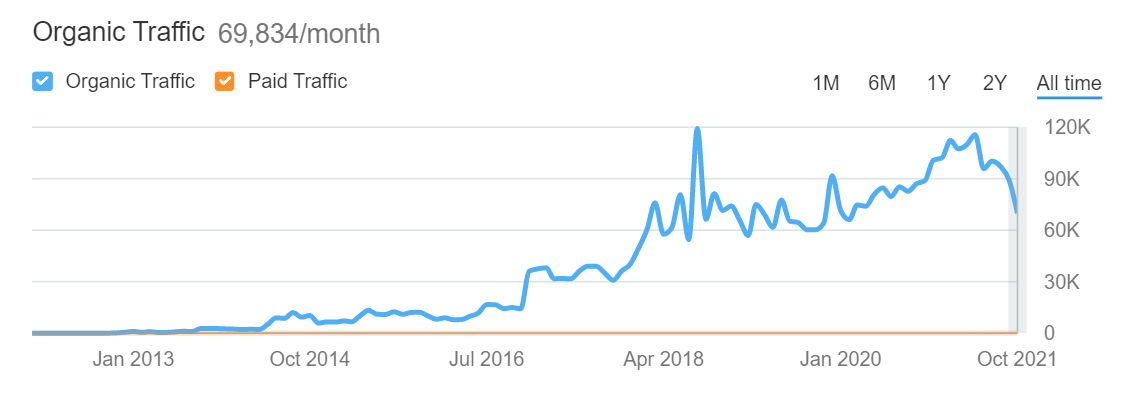There’s a common misconception that a blog is the best content strategy for all SaaS companies.
While I love blogs, they’re only one piece of the puzzle – and one piece does not a comprehensive strategy make.
Having worked with a number of SaaS companies over the years, I’ve found that creating content repositories oftentimes makes more sense with how unique SaaS user journeys are.
In this article, you’ll learn how comparison content, educational content, and support content can engage users at essential touchpoints on the path to conversion.
[Related:] Structure A Scalable Content Program For SaaS →
Comparison Content Repositories
Consumers in the SaaS space, while searching with solution lead queries will also use “versus” and “alternative” queries to find service providers who may not necessarily rank highly for the marquee product phrases.
This broadens the competitive landscape outside of just who is ranking page one for the typical target phrases.
These are worth using “business intelligence” combined with metrics like search volume to prioritize which comparison pages should be generated.
The focus here isn’t to generate high volumes of traffic, as anyone searching brand X versus brand Y will have some level of marketplace education and may likely be close to conversion.
Gitlab’s Comparison Repository
Gitlab has a large comparison repository that at the time of writing consists of 123 pages and ranks for 3,024 keywords, generating an estimated 11,000 sessions a month (Semrush U.S.).
This is a powerful content hub, as Gitlab has a product offering that has a large overlap with a number of other providers.
These comparison pages enable users researching specific product features to put Gitlab on their radar when on the face of it, a DevOps platform might not seem relevant (depending on the consumer’s market knowledge).
 Screenshot from About.gitlab.com, July 2021
Screenshot from About.gitlab.com, July 2021This also acts as a tool to move users to the next stage of the funnel with Gitlab, and links through to these pages are linked prominently from the homepage.
[Find Out:] How To Develop (And Perfect) A SaaS Content Funnel →
Notions’ Comparison Pages
Notion has taken a different approach to comparison content by singling out two of its main competitors – Evernote & Confluence – with specific comparison pages linked to the site footer.
These pages capitalize on the market knowledge, generated through general marketing and reputation, with the Evernote comparison page ranking for 208 keywords and the Confluence page ranking for 82 keywords.
Educational Content Repositories
Providing a single “value proposition” or looking at the search intent of keywords in a linear fashion can be difficult.
As-A-Service organizations tend to have varying customer bases with differing levels of need, buying power, and technical capabilities (and knowledge) around the product, as well as a narrow-view approach to optimizing for organic users.
This is why the content hub/SEO moat approach is so powerful in this niche.
In terms of a traditional SEO view, it creates a lot of good content including a number of target keywords and their variations.
Taking a wider view, producing strong, non-commercial content covering a large number of topics (and search queries) within a well structured (and internally linked) area of the website creates a content repository with a large number of varying user value propositions that caters to users at different stages of their journey.
It also helps improve the topical relevancy of the domain as a whole.
When a SaaS client published the first section of what has become a large, comprehensive “learning center” in mid-2017, Google began to crawl and see value in this content area.
The website also began to improve rankings across a number of commercially valuable phrases on more commercially focused landing pages.
This learning center, four years on, now ranks for an estimated 151,247 keywords (31,000 of which are on page one). It generates 1,378,281 organic sessions a month – around 25% of the domain’s total estimated organic traffic.
 Screenshot from Semrush, October 2021
Screenshot from Semrush, October 2021When building educational repositories like this, it’s essential to be as commercially agnostic as possible. The goal of this content is to improve domain topical relevancy and bring users to the site.
Including heavily commercial CTAs and sales language across these pages can dilute their value propositions and limit ranking potential.
Google examples of these content hubs in the wild include:
- Imperva’s learning center.
- Atlassian university.
- Asana academy.
- Adobe learning center.
- StackPath edge academy.
Educational repositories also create a really natural location within a website’s architecture to include large term glossaries that can internally link to both pages within the learning center and to commercial pages.
Support Content Repositories
When I start working with a SaaS (or tech) company, the support section is one area where there are oftentimes “quick wins” in terms of both increasing relevant traffic and content production.
The reason I say “quick” in terms of content production is that all the content needs to do is satisfy the user query.
For a large number of support articles and entries, these can be short two to three sentence pieces that link off to documentation or other articles/pages.
To find the questions that you need to be answering in your support documentation, there are a number of sources you should utilize and combine:
- Google’s PAA (People Also Asked) feature.
- Reddit, Quora, StackOverflow – anywhere where users may be posting questions relevant to your brand/product.
- Third-party SEO tools that allow question filtering.
In this process, you may also find elements to include in your other repositories, but you want to be more focused on your brand/product here.
[Discover:] Content Formats And Messaging To Gain New SaaS Customers →
By focusing on the Support Center, you can massively increase the amount of value it’s bringing your site as a whole.
For example, in the graph below, optimization, pruning, and consolidation started in mid-2016. Creating relevant support articles became a feature of new product GTMs (go-to-market strategies) to continuously add content to that area of the site.
 Screenshot from Semrush, October 2021
Screenshot from Semrush, October 2021Conclusion
While SaaS companies will have different content needs to fulfill their marketing objectives, the goal is always the same: Get a user into your business.
Any successful content strategy, then, will need to be customized to match takeaways for different types of users along their journey.
And as you’ve seen with the three examples above, different strategies can work very well in tandem.
*All data used is publicly accessible via third-party tools.
More Resources:
- How To Optimize A SaaS Homepage: Keywords, Linking & More
- How To Create SaaS Content For Increased Acquisition & Retention
- SaaS Content Marketing: A Complete Guide
Featured Image: ArtemisDiana/Shutterstock





![AI Overviews: We Reverse-Engineered Them So You Don't Have To [+ What You Need To Do Next]](https://www.searchenginejournal.com/wp-content/uploads/2025/04/sidebar1x-455.png)